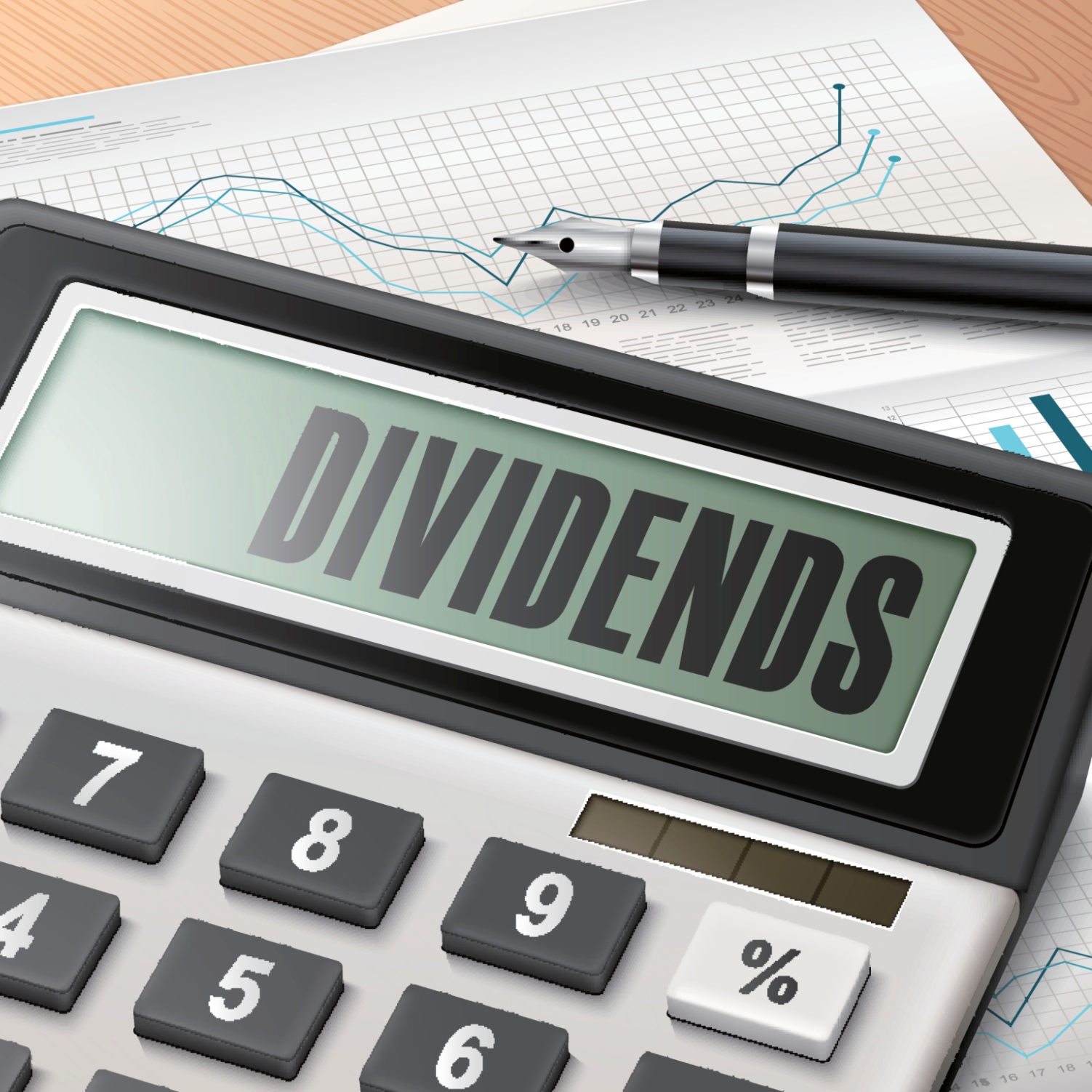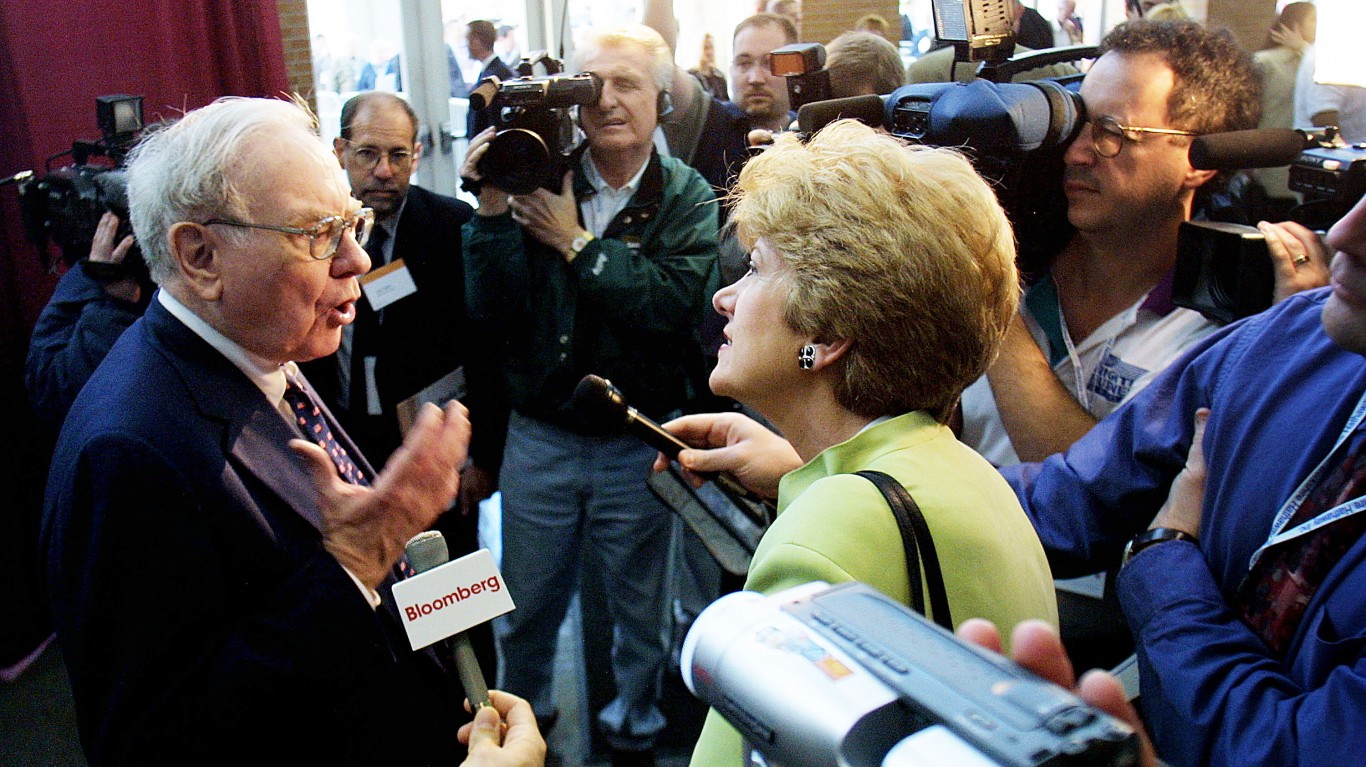
Investors love dividends. Whether the market is up or down, many investors need those dividends to help pay income in retirement. Dividends also account for up to half of all shareholder returns through time. While high dividends are desirable for investors, savvy investors know that not all dividends are created equal.
24/7 Wall St. has conducted a review of the top dividends from America’s largest companies. Almost all the companies should be recognizable to most Americans. It turns out that there were 25 large companies paying a yield of 3.5% or more — and some much higher.
The reason that the 3.5% dividend yield matters so much to equity investors is that this is 1% higher than the average yields of the S&P and Dow. This was also more than 100 basis points higher than the average yield of the 10-year to 30-year Treasury. The volatile dividends for real estate investment trusts (REITs) were excluded, while the safer dividends from utilities and other sectors were included. Much of the retail segment’s high dividend yields may have a similar set of caveats, and they may feel driven by lower and lower share prices.
As of the last week of June 2017, the average S&P 500 Index yield was 2.37% and the average yield of the 30 Dow Jones Industrial Average stocks was 2.43%. The huge difference between the Dow and the S&P 500 is that all Dow stocks currently pay dividends — while there were close to 80 non–dividend payers in the S&P 500, and the index includes the higher-yielding REITs.
The yield of the 10-year Treasury note was last seen at just 2.13% and the yield on the 30-year Treasury bond was just 2.70%. The difference between the Treasury yields and equity yields is that the former are locked. Many of these major dividend paying companies should grow their revenue and earnings in the years ahead, and investors assume dividend and earnings growth in future years also will translate to higher share prices.
24/7 Wall St. used data from Thomson Reuters on financials and on target prices, and some extra color and commentary on what has driven these high yields also has been provided. The consensus analyst share price targets from Thomson Reuters have been used to show whether Wall Street thinks each company’s stock has room to appreciate or if they think there is already a fair value.
Here are 25 great American companies paying dividends that 3.5% yield or greater.
Macy’s
> Yield: 6.78%
> Price: $22.46
> Mean price target: $25.79
> 52-week range: $21.51 to $45.41
> Market cap: $6.8 billion
Macy’s Inc. (NYSE: M) has the highest dividend yield of major retailers at this time. Its stock also has been brutalized by the growth of Amazon, and Macy’s has been unable to turn its own omni-channel up enough to offset in-store sale erosion. Its yield was already high a year ago, but the big dividend yield growth for new investors has been due to the pain of a falling stock price for existing shareholders. Macy’s is also pursuing more store closures to focus on the most profitable locations. At the start of 2017, Macy’s had almost 150,000 employees and operated about 830 stores under the Macys, Bloomingdales, Bloomingdales The Outlet, Macys Backstage and Bluemercury banners.
Kohl’s
> Yield: 5.94%
> Price: $37.38
> Mean price target: $40.52
> 52-week range: $35.16 to $59.67
> Market cap: $6.4 billion
Kohl’s Corp. (NYSE: KSS) has faced many of the same issues as Macy’s, including the rise of Amazon and e-commerce. As of January 28, 2017, Kohl’s operated 1,154 department stores, 12 FILA outlets and another three Off-Aisle clearance centers.
Seagate Technology
> Yield: 5.91%
> Price: $42.39
> Mean price target: $46.23
> 52-week range: $20.77 to $50.96
> Market cap: $12.6 billion
Seagate Technology PLC (NASDAQ: STX) is best known for its storage devices, and it is currently one of the dividend kings of the technology sector. It operates globally and dominates in storage devices, with a focus on hard drives, solid state drives and portable drives.
Ford
> Yield: 5.43%
> Price: $11.10
> Mean price target: $12.80
> 52-week range: $10.67 to $14.04
> Market cap: $44.2 billion
Ford Motor Co. (NYSE: F) has a better dividend than a stock performance of late. It has struggled to find direction in the post-Mulally years and is soon to have a new chief executive. At the same time, Ford has been experiencing a peak-auto trend in the United States as it seems hard to imagine the 2016 sales cycle being as robust in the year and years ahead.
Staples
> Yield: 5.17%
> Price: $9.19
> Mean price target: $9.80
> 52-week range: $7.24 to $10.25
> Market cap: $6.0 billion
Staples Inc. (NASDAQ: SPLS) is the king of all independent retailers of office supplies. That being said, it is under a relatively new leadership now that its acquisition of rival Office Depot failed to get approved. Staples has been a rumored buyout candidate of its own, but it also faces the Amazon and small e-commerce impact that has been a challenge to much of the retail landscape.
AT&T
> Yield: 5.16%
> Price: $38.13
> Mean price target: $39.68
> 52-week range: $36.10 to $43.89
> Market cap: $234.4 billion
AT&T Inc. (NYSE: T) is still the king of major telecom dividends, but its lead over Verizon has come in. AT&T has already diversified with its acquisition of DirecTV, and it is further trying to diversify with the pending acquisition of Time Warner to further spread into cable, telecom and content. AT&T’s revenue was almost $164 billion in 2016.
Verizon
> Yield: 5.09%
> Price: $45.81
> Mean price target: $50.05
> 52-week range: $44.46 to $56.95
> Market cap: $186.9 billion
Verizon Communications Inc. (NYSE: VZ) has the highest yield of the Dow Jones Industrial Average. The company has so far been less of an acquirer than rival AT&T, but it has now acquired AOL and Yahoo and plans to grow its video and ad platforms. Its revenue was $126 billion in 2016.
Occidental Petroleum
> Yield: 5.06%
> Price: $60.24
> Mean price target: $71.44
> 52-week range: $57.20 to $78.48
> Market cap: $46.1 billion
Occidental Petroleum Corp. (NYSE: OXY) is not the largest of the oil companies in raw market value, but it is the largest oil and gas dividend of the integrated players. Some of that dividend boost is because its shares are way down from the highs, and a weak oil market might be a continued risk to Occidental and all oil and gas players. Occidental’s 2016 revenue of $10 billion was almost half of the revenues just two years earlier.
FirstEnergy
> Yield: 4.98%
> Price: $30.04
> Mean price target: $33.53
> 52-week range: $27.93 to $36.60
> Market cap: $13.3 billion
FirstEnergy Corp. (NYSE: FE) is an electricity utility and generator via coal-fired, nuclear, hydroelectric, oil and natural gas, wind and solar power generating facilities. The company serves approximately 6 million customers in Ohio, Pennsylvania, West Virginia, Maryland, New Jersey and New York.
Target
> Yield: 4.89%
> Price: $51.45
> Mean price target: $58.12
> 52-week range: $48.56 to $79.33
> Market cap: $28.4 billion
Target Corp. (NYSE: TGT) is in the middle of a tight retail market, wedged somewhere between the cross-hairs of Walmart and Amazon. The drop in Target’s shares has been far worse than rival Walmart, and that has helped to drive up the dividend. Despite having revenue of $69.5 billion in 2016, that is down from almost $74 billion the prior year.
Southern Company
> Yield: 4.65%
> Price: $50.17
> Mean price target: $51.16
> 52-week range: $46.20 to $54.64
> Market cap: $49.9 billion
Southern Co. (NYSE: SO) is another electric utility and has power generation assets, sells wholesale electricity and distributes natural gas. Southern is based in Atlanta and claims roughly 9 million customers spread over electric and natural gas. Its 11 regulated utility markets are in Georgia, Virginia, Tennessee, Alabama, Florida, Mississippi, Louisiana, Texas, Oklahoma and several more states.
General Motors
> Yield: 4.44%
> Price: $34.29
> Mean price target: $39.50
> 52-week range: $27.34 to $38.55
> Market cap: $51.8 billion
General Motors Co. (NYSE: GM) might be its own company again since its notorious bankruptcy and re-emergence as a public company. The stock also has been pretty much a nothing-burger since that IPO, and just like rival Ford, GM faces tough comparisons for a peak U.S. auto trend. Still, GM has been unwinding some money-losing and less profitable efforts in Europe.
Entergy
> Yield: 4.41%
> Price: $79.60
> Mean price target: $78.69
> 52-week range: $66.71 to $82.09
> Market cap: $14.3 billion
Entergy Corp. (NYSE: ETR) is an electric utility based in New Orleans. It serves portions of Arkansas, Mississippi, Texas and Louisiana, including the City of New Orleans. It distributes natural gas and delivers electricity to 2.9 million utility customers. Overall Entergy is one of the big players among utilities in the deep south. Although it operates through several different subsidiaries, it has over 14,000 employees. The stock has made steady gains over the past few years, and it is actually closing in on an all-time high — with a dividend like this, that says something.
Valero Energy
> Yield: 4.24%
> Price: $66.28
> Mean price target: $73.89
> 52-week range: $46.88 to $71.40
> Market cap: $29.6 billion
Valero Energy Corp. (NYSE: VLO) is a top petroleum refiner and ethanol producer in the country, and its stock can be volatile around the swings in oil pricing and also around how the refining sector’s margins grow and contract. Its revenue of more than $75 billion in 2016 is down handily from prior years, but much of that is price-driven by commodity prices rather than its raw profitability. Unlike traditional oil companies, refining companies do not thrive as well under high oil prices as the margins are tougher. As of December 31, 2016, the company owned 15 petroleum refineries with a combined throughput capacity of approximately 3.1 million barrels per day, and it owned and operated 11 ethanol plants with a combined capacity of approximately 1.4 billion gallons per year.
Gap
> Yield: 4.19%
> Price: $22.27
> Mean price target: $25.53
> 52-week range: $19.33 to $30.74
> Market cap: $8.8 billion
Gap Inc. (GPS) has become a post-growth retailer after prior decades of expansion, and it is facing many of the same Amazon-related and e-commerce pressure of other retailers. The company has consolidated many stores under the namesake Gap brand, and it has Old Navy and Banana Republic brands. Gap also owns Athleta and Intermix. As of March 14, 2017, the company operated 3,200 company-operated stores and 450 franchise stores. Gap’s revenue of $15.5 billion in 2016 was the third straight year of decline and its pretax net income of $1.12 billion in 2016 was down from over $2 billion in 2014 and 2013.
Williams Companies
> Yield: 4.17%
> Price: $28.81
> Mean price target: $33.37
> 52-week range: $19.60 to $32.69
> Market cap: $23.8 billion
Williams Companies Inc. (NYSE: WMB) is an energy infrastructure company that operates oil and gas pipelines. Its primary natural gas pipeline system extends from Texas, Louisiana, Mississippi and the offshore Gulf of Mexico through Alabama, Georgia, South Carolina, North Carolina, Virginia, Maryland, Delaware, Pennsylvania and New Jersey to the New York City metropolitan area. Other pipelines cover parts of the central and western states. The Tulsa-based company dates back to 1908.
Chevron
> Yield: 4.11%
> Price: $104.42
> Mean price target: $122.48
> 52-week range: $97.53 to $119.00
> Market cap: $197.8 billion
Chevron Corp. (NYSE: CVX) may not be the size in market cap of rival Exxon Mobil, but it outyields its larger rival. Chevron has seen its ups and downs with the price of oil, but it has pledged to not disrupt its dividend unless it simply faces no other serious alternatives. Revenues of $110 billion in 2016 were down from $200 billion just two years earlier.
PPL
> Yield: 4.07%
> Price: $39.34
> Mean price target: $38.96
> 52-week range: $32.08 to $40.20
> Market cap: $26.9 billion
PPL Corp. (NYSE: PPL) is an electric utility based in Allentown, Pennsylvania, and its three operating units are U.K. Regulated, Kentucky Regulated and Pennsylvania Regulated. The company dates back to 1920, and it claims to have more than 10 million utility customers in the United States and United Kingdom.
Qualcomm
> Yield: 4.01%
> Price: $56.51
> Mean price target: $61.55
> 52-week range: $50.84 to $71.62
> Market cap: $83.5 billion
Qualcomm Inc. (NASDAQ: QCOM) has been the king of processors in the mobile phone and tablet arena. Its growth recently ran into some headwinds as customers such as Apple have chosen to in-house or go to cheaper rivals, and the company also has had royalty disputes. Now Qualcomm is hoping to bolster its growth and diversify its revenues away from just expensive microprocessors with the acquisition of a much more diversified NXP Semiconductors in a deal valued at close to $40 billion.
Duke Energy
> Yield: 3.98%
> Price: $86.80
> Mean price target: $84.75
> 52-week range: $72.34 to $87.75
> Market cap: $60.8 billion
Duke Energy Corp. (NYSE: DUK) is easily one of the largest utility providers with a portfolio that covers the east coast through the Midwest. This company is more or less the gold standard when it comes to utility stocks, and many of the stocks within the industry take their bearings from it. Although utilities are known for trading on their dividends, Duke has made a noteworthy run so far this year.
IBM
> Yield: 3.89%
> Price: $155.16
> Mean price target: $165.07
> 52-week range: $142.50 to $182.79
> Market cap: $145.8 billion
International Business Machines Corp. (NYSE: IBM) has been a large buyback and dividend payer for years, but the company had to abandon part of its artificial earnings per share growth efforts. IBM has been growing in its emerging opportunities in cloud, Watson and other efforts, but its legacy IT-consulting operations have been bleeding off faster than IBM can grow its emerging tech businesses. The company still has around 380,000 employees. A slew of earnings disappointments has been a thorn in its side, and IBM may need new leadership quite soon if it cannot get that turnaround underway. Its revenue was almost $80 billion in 2016 and was down each year consecutively since at least 2012.
Exxon Mobil
> Yield: 3.77%
> Price: $81.33
> Mean price target: $87.13
> 52-week range: $79.26 to $95.55
> Market cap: $344.6 billion
Exxon Mobil Corp. (NYSE: XOM) shares have suffered with the fate of oil prices, and its massive $31 billion acquisition of XTO Energy for natural gas was done at a time that the economics of today’s energy prices haven’t been so great. Exxon’s 2016 revenues of over $218 billion were down from $394 billion in 2014 and were half of the $451 billion in 2012. At least Exxon gets to claim that its former CEO became Secretary of State.
Pfizer
> Yield: 3.75%
> Price: $34.07
> Mean price target: $37.35
> 52-week range: $29.83 to $37.93
> Market cap: $203.3 billion
Pfizer Inc. (NYSE: PFE) has struggled to find growth for years. Its drugs have faced the same patent cliff of much of Big Pharma rivals. Still, its dividend is deemed safe by investors, and 2016 revenues of $52.8 billion bumped up from the average of the prior three years.
Cisco Systems
> Yield: 3.61%
> Price: $32.31
> Mean price target: $35.43
> 52-week range: $27.13 to $34.60
> Market cap: $161.5 billion
Cisco Systems Inc. (NASDAQ: CSCO) has been one of the top technology companies in networking. It has made hundreds of small bolt-on acquisitions around future technology, and Cisco hopes that security integration can help bolster its sales ahead. Long-time CEO John Chambers has turned the helm over to Chuck Robbins, and Cisco has been in the midst of two large restructurings in the past five years in an effort to “right-size” its headcount and unit structure. Cisco’s revenue was $37 billion in 2016, and it has been stable but choppy over the past five years, but without any real growth. Cisco shares also remain well down from the tech bubble days back in 1999 to 2000.
Exelon
> Yield: 3.59%
> Price: $37.34
> Mean price target: $39.47
> 52-week range: $29.82 to $37.70
> Market cap: $34.6 billion
Exelon Corp. (NYSE: EXC) is a Chicago-based utility targeting electric and natural gas customers. Its operations in electricity are in parts of Illinois, Pennsylvania, Delaware and Maryland. Its natural gas markets are in the same and adjacent markets, and it also provides manpower services for the utility industry in America. Exelon claims to have one of the cleanest and lowest-cost power generation fleets going, and it also represents some 10 million customers.
Take Charge of Your Retirement In Just A Few Minutes (Sponsor)
Retirement planning doesn’t have to feel overwhelming. The key is finding expert guidance—and SmartAsset’s simple quiz makes it easier than ever for you to connect with a vetted financial advisor.
Here’s how it works:
- Answer a Few Simple Questions. Tell us a bit about your goals and preferences—it only takes a few minutes!
- Get Matched with Vetted Advisors Our smart tool matches you with up to three pre-screened, vetted advisors who serve your area and are held to a fiduciary standard to act in your best interests. Click here to begin
- Choose Your Fit Review their profiles, schedule an introductory call (or meet in person), and select the advisor who feel is right for you.
Why wait? Start building the retirement you’ve always dreamed of. Click here to get started today!
Thank you for reading! Have some feedback for us?
Contact the 24/7 Wall St. editorial team.





